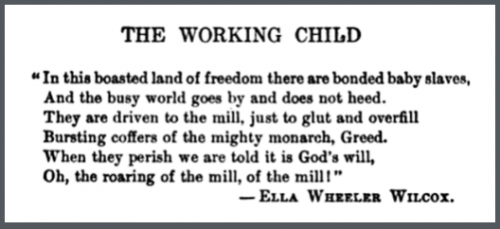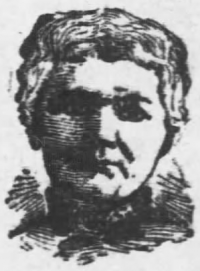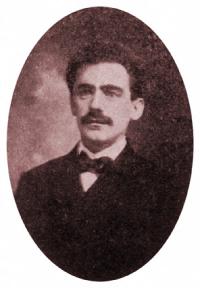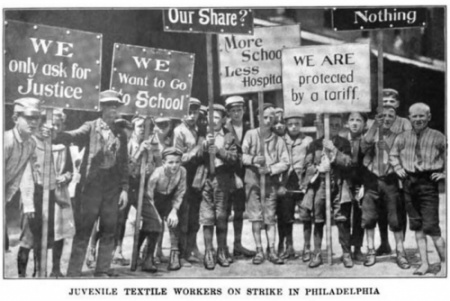Hellraisers Journal: Mother Jones on Hideous Conditions Of Child Slavery in Southern Cotton Mills
"Of such is the kingdom of Heaven,"
said the great teacher.
Well, if Heaven is full of undersized,
round shouldered, hollow-eyed,
listless, sleepy little angel children,
I want to go to the other place with the bad little boys and girls.
-Mother Jones
Tuesday May 29, 1906
From The Labor World: Mother Jones on Child Labor

From the Duluth Labor World of May 26, 1906:
CHILD SLAVERY IN THE SOUTH
-----Mother Jones Draws Picture
of Hideous Conditions in
the Cotton Mills.
-----
"Mother" Jones is a remarkable woman. She attained fame as a sociologist during the great anthracite strike. She is over sixty years old, but under her marble white skin there is a tint of pink that a girl of 17 might envy. Her hair is as white as snow but out of her blue Irish eye there is a flash of youthful good nature and a good soul which makes the old lady attractive to anyone who comes in contact with her.
[Said "Mother" Jones:]
I have Just returned from a trip through South Carolina...The child slavery that New England once had has been transferred down there and the greatest industrial slavery in the world, I believe is now found in the cotton mills around Greenville, S. C. Greenville is the capital of the state. Capitalistic slavery is better pictured there than in any other place I ever saw in the world.
They regard the individual as a tool or a machine, if he gets hurt they throw him into a hospital and repair him. If he dies there is a church near by from which they bury him. And the preacher in this church preaches the doctrine of obedience at all times. He preaches the doctrine of non-resistance to those above us.
He thunders against labor unions and thunders against anything but work.
Children six years old are working in these places, and when you look the children 14 years of age you think they are old men and women.
The Southern people do not seem to own many of these great cotton factories. The most prosperous are owned by New England people. The New Englanders themselves protested against African slavery. Now the New Englanders are making money out of the blood and bones of white children in the South, who are more abject slaves than was the blackest that ever came out of Guinea.
Christ was a Socialist. He taught Socialism in its highest form. The trouble today is that the preachers for the most part have cast away the teaching of Christ.
I have been reading of the treason of the senate. I believe the United
States senate is the palace of privilege.It is the greatest political curse that is on the people.
But things are looking up, and better times are ahead for us all, I hope.
Are you Welsh, Mother Jones?" was a question a, young man put to her while she was in Clarence Darrow's office the other day, talking reform with Mr. Darrow and the other advanced thinkers.
"Sure I am not," she replied. "I was born in Ireland, brought up in Canada, and have spent the greater part of my life in the United States." And then "Mother" Jones fell away from her ordinary manner of conversation and used language which showed her to be a woman of gentel [genteel] birth and gentle breeding.
~~~~~~~~~~~~~~~~~~~~
John Spargo on Enslavement of Children
in the Textile Industries
From The Bitter Cry of the Children:
The textile industries rank first in the enslavement of children. In the cotton trade, for example, 13.3 per cent of all persons employed throughout the United States are under sixteen years of age. In the Southern states, where the evil appears at its worst, so far as the textile trades are concerned, the proportion of employees under sixteen years of age in 1900 was 25.1 per cent, in Alabama the proportion was nearly 30 per cent. A careful estimate made in 1902 placed the number of cotton-mill operatives under sixteen years of age in the Southern states at 50,000.
At the beginning of 1903 a very conservative estimate placed the number of children under fourteen employed in the cotton mills of the South at 30,000, no less than 20,000 of them being under twelve. If this latter estimate of 20,000 children under twelve is to be relied upon, it is evident that the total number under fourteen must have been much larger than 30,000. According to Mr. McKelway, one of the most competent authorities in the country, there are at the present time not less than 60,000 children under fourteen employed in the cotton mills of the Southern states.
Miss Jane Addams tells of finding a child of five years working by night in a South Carolina mill; Mr. Edward Gardner Murphy has photographed little children of six and seven years who were at work for twelve and thirteen hours a day in Alabama mills. In Columbia, S.C., and Montgomery, Ala., I have seen hundreds of children, who did not appear to be more than nine or ten years of age, at work in the mills, by night as well as by day.
The industrial revival in the South from the stagnation consequent upon the Civil War has been attended by the growth of a system of child slavery almost as bad as that which attended the industrial revolution in England a century ago. From 1880 to 1900 the value of the products of Southern manufactures increased from less than $458,000,000 to $1,463,000,000—an increase of 220 per cent.
Many factors contributed to that immense industrial development of the South, but, according to a well-known expert, it is due "chiefly to her supplies of tractable and cheap labor." During the same period of twenty years in the cotton mills outside of the South, the proportion of workers under sixteen years of age decreased from 15.6 per cent to 7.7 per cent, but in the South it remained at approximately 25 per cent. It is true that the terrible pauper apprentice system which forms such a tragic chapter in the history of the English factory movement has not been introduced; yet the fate of the children of the poor families from the hill districts who have been drawn into the vortex of this industrial development is almost as bad as that of the English pauper children.
These "poor whites," as they are expressively called, even by their negro neighbors, have for many years eked out a scanty living upon their farms, all the members of the family uniting in the struggle against niggardly nature. Drawn into the current of the new industrial order, they do not realize that, even though the children worked harder upon the farms than they do in the mills, there is an immense difference between the dust-laden air of a factory and the pure air of a farm; between the varied tasks of farm life with the end less opportunities for change and individual initiative, and the strained attention and monotonous tasks of mill life.
The lot of the pauper children driven into the mills by the ignorance and avarice of British Bumbledom was little worse than that of these poor children, who work while their fathers loaf. During the long, weary nights many children have to be kept awake by having cold water dashed on their faces, and when morning comes they throw themselves upon their beds—often still warm from the bodies of their brothers and sisters—without taking off their clothing. "When I works nights, I'se too tired to undress when I gits home, an' so I goes to bed wif me clo's on me," lisped one little girl in Augusta, Ga.
There are more than 80,000 children employed in the textile industries of the United States, according to the very incomplete census returns, most of them being little girls. In these industries conditions are undoubtedly worse in the Southern states than elsewhere, though I have witnessed many pitiable cases of child slavery in Northern mills which equalled almost anything I have ever seen in the South.
During the Philadelphia textile workers' strike in 1903, I saw at least a score of children ranging from eight to ten years of age who had been working in the mills prior to the strike. One little girl of nine I saw in the Kensington Labor Lyceum. She had been working for almost a year before the strike began, she said, and careful inquiry proved her story to be true.
When " Mother" Mary Jones started with her little "army" of child toilers to march to Oyster Bay, in order that the President of the United States might see for himself some of the little ones who had actually been employed in the mills of Philadelphia, I happened to be engaged in assisting the strikers. For two days I accompanied the little "army" on its march, and thus had an excellent opportunity of studying the children. Amongst them were several from eight to eleven years of age, and I remember one little girl who was not quite eleven telling me with pride that she had "worked two years and never missed a day."
One evening, not long ago, I stood outside of a large flax mill in Paterson, N.J., while it disgorged its crowd of men, women, and children employees. All the afternoon, as I lingered in the tenement district near the mills, the comparative silence of the streets oppressed me. There were many babies and very small children, but the older children, whose boisterous play one expects in such streets, were wanting.
"If thow'lt bide till th' mills shut for th' day, thow'lt see plenty on 'em-big kids as plenty as small taties," said one old woman to whom I spoke about it. She was right. At six o'clock the whistles shrieked, and the streets were suddenly filled with people, many of them mere children. Of all the crowd of tired, pallid, and languid-looking children I could only get speech with one, a little girl who claimed thirteen years, though she was smaller than many a child of ten. Indeed, as I think of her now, I doubt whether she would have come up to the standard of normal physical development either in weight or stature for a child of ten.
One learns, however, not to judge the ages of working children by their physical appearance, for they are usually behind other children in height, weight, and girth of chest,—often as much as two or three years. If my little Paterson friend was thirteen, perhaps the nature of her employment will explain her puny, stunted body.
She works in the "steaming room" of the flax mill. All day long, in a room filled with clouds of steam, she has to stand bare footed in pools of water twisting coils of wet hemp. When I saw her she was dripping wet, though she said that she had worn a rubber apron all day. In the coldest evenings of winter little Marie, and hundreds of other little girls, must go out from the super heated steaming rooms into the bitter cold in just that condition. No wonder that such children are stunted and underdeveloped!
In textile mill towns like Biddeford, Me., Manchester, N.H., Fall River and Lawrence, Mass., I have seen many such children, who, if they were twelve or fourteen according to their certificates and the companies' registers, were not more than ten or twelve in reality. I have watched them hurrying into and away from the mills, "those receptacles, in too many instances, for living human skeletons, almost disrobed of intellect," as Robert Owen's burning phrase describes them.
I do not doubt that, upon the whole, conditions in the textile industries are better in the North than in the South, but they are nevertheless too bad to permit of self-righteous boasting and complacency. And in several other departments of industry conditions are no whit better in the North than in the South. The child-labor problem is not sectional, but national.
[Photographs added and Spargo's source numbers removed. This book and a review of Spargo's sources highly recommend.]

From The New York Times of February 17, 1906
``````````
~~~~~~~~~~~~~~~~~~~~
SOURCES
The Labor World
(Duluth, Minnesota)
-May 26, 1906
http://chroniclingamerica.loc.gov/lccn/sn78000395/1906-05-26/ed-1/seq-2/
The Bitter Cry of the Children
-by John Spargo
Macmillan, Feb 1906
https://books.google.com/books?id=jRtShCzm4ygC
Chapter III-The Working Child
https://books.google.com/books/reader?id=jRtShCzm4ygC&printsec=frontcove...
IV-Textile Industries
https://books.google.com/books/reader?id=jRtShCzm4ygC&printsec=frontcove...
IMAGES
Child Labor, Spargo Bitter Cry of Children, Poem Wilcox, Feb 1906
https://books.google.com/books/reader?id=jRtShCzm4ygC&printsec=frontcove...
Mother Jones, Appeal to Reason, Mar 11, 1905
http://www.newspapers.com/image/66992169/
John Spargo, 1902
https://en.wikipedia.org/wiki/John_Spargo
March of Mill Children of 1903, Spargo Bitter Cry of Children, Feb 1906
https://books.google.com/books/reader?id=jRtShCzm4ygC&printsec=frontcove...
Bitter Cry of Children, Spargo, NYT, Feb 17, 1906
https://www.newspapers.com/image/20459100/
Fingers to the Bone: Child Farmworkers in the United States
[video:https://www.youtube.com/watch?v=NfEtO00DSvI width:500 height:315]
Babies in the Mill - Dorsey Dixon





Comments
Ye gods, JayRae, what a catalogue of capitalist horrors. They
sure don't teach any of that in school, do they? The capitalists don't want us to remember child slavery because they're working so damned hard to bring it back. Thanks for keeping the children in The Long Memory. If there be a kingdom, they will be the judges. If there be not a kingdom, we are still assured that karma will work its way through everything in the universe.
Resilience: practical action to improve things we can control.
3D+: developing language for postmodern spirituality.
yep, the long memory
I truly mean to make certain that we never forget the crime of putting little children to work in the mines and the mills of this country and that we remember and curse those capitalist who wrung wealth and riches out of their little bodies.
Never be deceived that the rich will allow you to vote away their wealth.-Lucy Parsons